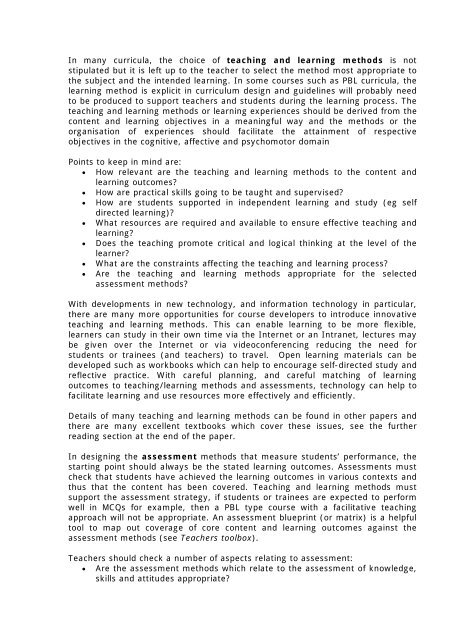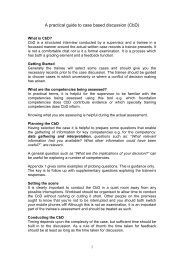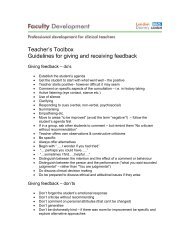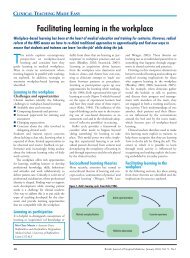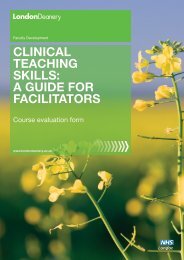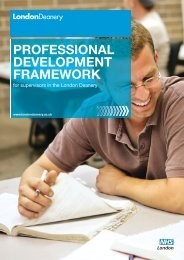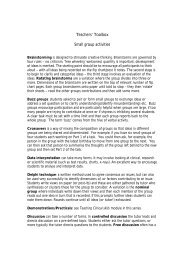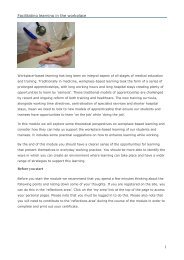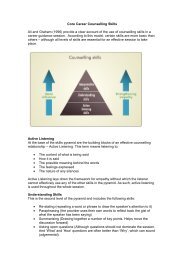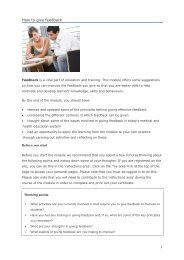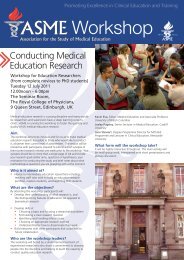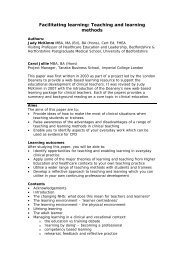Curriculum development module - Faculty Development - London ...
Curriculum development module - Faculty Development - London ...
Curriculum development module - Faculty Development - London ...
You also want an ePaper? Increase the reach of your titles
YUMPU automatically turns print PDFs into web optimized ePapers that Google loves.
In many curricula, the choice of teaching and learning methods is not<br />
stipulated but it is left up to the teacher to select the method most appropriate to<br />
the subject and the intended learning. In some courses such as PBL curricula, the<br />
learning method is explicit in curriculum design and guidelines will probably need<br />
to be produced to support teachers and students during the learning process. The<br />
teaching and learning methods or learning experiences should be derived from the<br />
content and learning objectives in a meaningful way and the methods or the<br />
organisation of experiences should facilitate the attainment of respective<br />
objectives in the cognitive, affective and psychomotor domain<br />
Points to keep in mind are:<br />
• How relevant are the teaching and learning methods to the content and<br />
learning outcomes?<br />
• How are practical skills going to be taught and supervised?<br />
• How are students supported in independent learning and study (eg self<br />
directed learning)?<br />
• What resources are required and available to ensure effective teaching and<br />
learning?<br />
• Does the teaching promote critical and logical thinking at the level of the<br />
learner?<br />
• What are the constraints affecting the teaching and learning process?<br />
• Are the teaching and learning methods appropriate for the selected<br />
assessment methods?<br />
With <strong>development</strong>s in new technology, and information technology in particular,<br />
there are many more opportunities for course developers to introduce innovative<br />
teaching and learning methods. This can enable learning to be more flexible,<br />
learners can study in their own time via the Internet or an Intranet, lectures may<br />
be given over the Internet or via videoconferencing reducing the need for<br />
students or trainees (and teachers) to travel. Open learning materials can be<br />
developed such as workbooks which can help to encourage self-directed study and<br />
reflective practice. With careful planning, and careful matching of learning<br />
outcomes to teaching/learning methods and assessments, technology can help to<br />
facilitate learning and use resources more effectively and efficiently.<br />
Details of many teaching and learning methods can be found in other papers and<br />
there are many excellent textbooks which cover these issues, see the further<br />
reading section at the end of the paper.<br />
In designing the assessment methods that measure students’ performance, the<br />
starting point should always be the stated learning outcomes. Assessments must<br />
check that students have achieved the learning outcomes in various contexts and<br />
thus that the content has been covered. Teaching and learning methods must<br />
support the assessment strategy, if students or trainees are expected to perform<br />
well in MCQs for example, then a PBL type course with a facilitative teaching<br />
approach will not be appropriate. An assessment blueprint (or matrix) is a helpful<br />
tool to map out coverage of core content and learning outcomes against the<br />
assessment methods (see Teachers toolbox).<br />
Teachers should check a number of aspects relating to assessment:<br />
• Are the assessment methods which relate to the assessment of knowledge,<br />
skills and attitudes appropriate?


